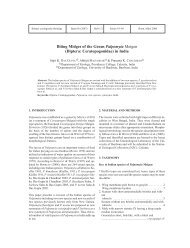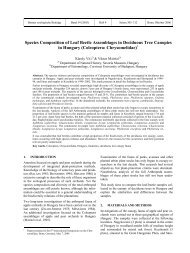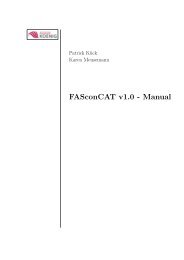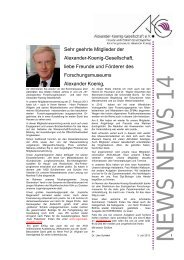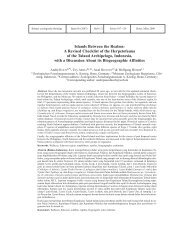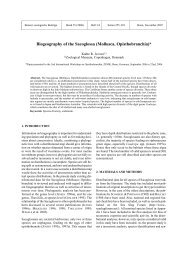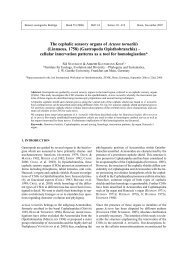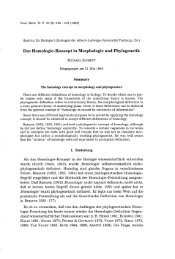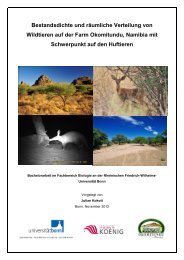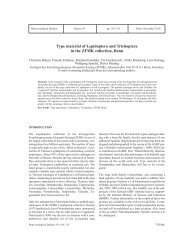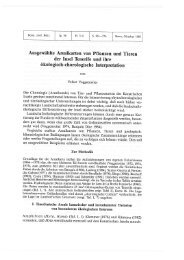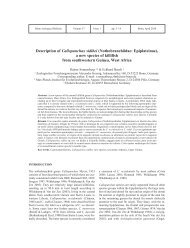Successful Husbandry and First Breeding of Varanus juxtindicus ...
Successful Husbandry and First Breeding of Varanus juxtindicus ...
Successful Husbandry and First Breeding of Varanus juxtindicus ...
You also want an ePaper? Increase the reach of your titles
YUMPU automatically turns print PDFs into web optimized ePapers that Google loves.
110<br />
Housing<br />
WESIAK AND KOCH - HUSBANDRY AND BREEDING OF VARANUS JUXTINDICUS<br />
The long-term <strong>and</strong> species-appropriate keeping<br />
<strong>and</strong> breeding <strong>of</strong> medium-sized to large monitor species<br />
is a fixed element in herpetoculture in most zoos <strong>and</strong><br />
some private households. Recent advances in light <strong>and</strong><br />
heating technique as well as knowledge about dietary<br />
requirements, particularly nutrition supplements, <strong>and</strong><br />
comprehensive veterinary support are the basis for a<br />
healthy <strong>and</strong> long life in captivity. For a comprehensive<br />
overview on published breeding results we refer, for<br />
instance, to Horn & Visser (1989, 1997) as well as to<br />
the references in Bennett (1996, 1998), Kirschner et al.<br />
(1996), <strong>and</strong> Eidenmüller (1997, 2003).<br />
The respectable body dimensions <strong>of</strong> V. <strong>juxtindicus</strong><br />
together with their strength <strong>and</strong> activity disallow the<br />
use <strong>of</strong> st<strong>and</strong>ard silicon terraria made <strong>of</strong> glass. Instead,<br />
the spacious terrarium has to be ordered or home-made<br />
following an elaborate concept. With respect to the<br />
individual structural elements <strong>of</strong> the apartment, the<br />
terrarium required a lightweight construction <strong>of</strong> robust,<br />
non-corrosive materials such as breeze blocks <strong>and</strong><br />
aluminum pr<strong>of</strong>iles to fix the glass plates (Fig. 9). The<br />
walls <strong>and</strong> flooring were covered with plaster cement <strong>and</strong><br />
synthetic resin (for a detailed description we refer to<br />
Wesiak [1996] <strong>and</strong> Wilms [2004]). Sliding glass doors<br />
are unsuitable, lockable glass doors are preferable. The<br />
more entries the terrarium has, the more effective it is<br />
to work inside. A large water feature was mounted at<br />
the bottom <strong>of</strong> the terrarium. A water inlet <strong>and</strong> waste<br />
pipe (leading directly into the sewer) was operable from<br />
Fig. 9. Terrarium in the former collection <strong>of</strong> KW for<br />
keeping large monitor species like V. <strong>juxtindicus</strong>.<br />
Photograph by Klaus Wesiak.<br />
outside the terrarium. A second, smaller terrarium with<br />
the same structure was indispensable to separate the<br />
females during gestation, egg deposition, <strong>and</strong> directly<br />
afterwards for recovery. The terrarium built in the corner<br />
<strong>of</strong> the room was pentagonal with a an area <strong>of</strong> about 3.75<br />
m 2 including the water feature <strong>and</strong> a height <strong>of</strong> 1.1 meters<br />
in front <strong>and</strong> 1.25 meters in the rear areas.<br />
Geographically relevant data about climate was taken<br />
from literature sources (e.g., Brockhaus 1982). <strong>Varanus</strong><br />
<strong>juxtindicus</strong> was kept perennially at high temperatures (27°<br />
to 30° C air temperature, water temperature not below<br />
27°C) <strong>and</strong> high relative air humidity. Water temperature<br />
did not decrease at night, because these monitors <strong>of</strong>ten<br />
used the water pond to sleep. A thermostat-regulated<br />
freezer protection <strong>of</strong> 400 W placed below the terrarium<br />
was used to warm the terrarium’s ground, air <strong>and</strong> water.<br />
The temperature sensor was supsended from the ceiling<br />
<strong>and</strong> inaccessible for the monitors.<br />
The enclosure’s artificial lighting was provided by<br />
four fluorescent lambs (36 W) which corresponded to the<br />
natural spectrum <strong>of</strong> sunlight. In addition, the monitors<br />
needed a place to warm-up, with local temperatures <strong>of</strong><br />
40° to 45°C combined with an UV ray lamp because they<br />
regularly spent long periods under the radiation source<br />
(Horn in Sauer et al., 2004; Böttcher, 2007; Lehmann,<br />
2007). One 120 W spot (from Osram) provided light<br />
<strong>and</strong> heat all day, while a 300 W Ultra Vitalux spot (also<br />
from Osram) was added two times per day for 45 min<br />
each in the morning <strong>and</strong> the afternoon. All electrical<br />
components <strong>and</strong> connections were out <strong>of</strong> reach from the<br />
monitors.<br />
Initial Quarantine<br />
Like other members <strong>of</strong> the V. indicus species group,<br />
which forage in mangrove swamps <strong>and</strong> rainforests<br />
(Philipp, 1999, Ziegler et al, 2001, Philipp et al., 2007),<br />
V. <strong>juxtindicus</strong> is probably an opportunistic predator <strong>and</strong><br />
is probably infested with parasites in the juvenile phase.<br />
Inadequate conditions by ruthless exporters <strong>and</strong> stress<br />
during transportation impair the health <strong>of</strong> monitors.<br />
Nematodes <strong>and</strong> protozoans (primarily Entamoeba<br />
invadens) in the intestinal tract, <strong>and</strong> nematodes <strong>and</strong><br />
pentastomes in the lungs cause severe inflammations <strong>of</strong><br />
the organs as secondary infections, generally with fatal<br />
consequences. These parasites are highly infectious <strong>and</strong><br />
can achieve epidemic proportions.<br />
Recently imported monitors were placed separately<br />
in quarantine. For feeding <strong>and</strong> cleaning, each terrarium<br />
had its own set <strong>of</strong> tools. Newspaper was used as substrate;<br />
excrement was immediately removed <strong>and</strong> the newspaper




